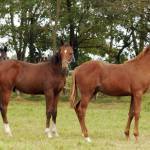Research on Lawsonia Infections in Weanling Horses

Lawsonia intracellularis is a bacterium that causes intestinal infections in a variety of species. In horses, these infections are termed equine proliferative enteritis (EPE) and are most common in weanlings aged 4 to 7 months old.
While the mode of transmission remains largely unknown, it is thought that the bacteria are shed from horses with an active infection and picked up by other horses that graze in areas contaminated with feces from sick weanlings.
EPE causes diarrhea, depression, fever, reduced appetite, weight loss, swelling of the abdomen and lower limbs, a poor hair coat, and intermittent colic due to thickening of the mucosal lining in the small and large intestines. Treatment options include antibiotics, supportive care, intravenous fluids, and plasma transfusions. Most treated horses survive, but they usually do not gain weight during the illness and are thus smaller at fall sales, tending to bring a lower price because of their size and rough appearance.
It is thought that weanlings are particularly susceptible to EPE because of the stress of weaning, a decline in maternal antibodies, immature immune systems in the weanling, and possibly parasite infestations. Researchers are attempting to answer questions such as why relatively few weanlings become ill, though many are exposed to L. intracellularis, and why some farms have much higher infection rates than others. There are also questions as to the role of transferred maternal antibodies in protecting weanlings from infections.
A research team led by Allen Page, D.V.M., and David Horohov, Ph.D., at the University of Kentucky used a group of six weanlings in a study. First, the researchers administered L. intracellularis bacteria to the weanlings through a nasogastric tube. The weanlings were monitored for signs of disease, and blood and fecal samples were collected at regular intervals. The horses were weighed once a week, and ultrasound was used weekly to check for thickening of the intestinal walls. The foals were necropsied at the end of the study to check for signs of infection in the small intestine. Of the six weanlings, four contracted forms of EPE, with one affected only subclinically. The remaining two weanlings showed no signs of EPE.
The team then worked on developing better ways to diagnose EPE. They developed a modified ELISA test that detects antibodies to L. intracellularis and used this blood assay to identify horses that had been exposed to the bacteria. After evaluating the seroprevalence of L. intracellularis among 337 Thoroughbred foals and weanlings residing on 25 farms in central Kentucky, they found an overall seroprevalence of 68%, with levels on individual farms ranging from 14-100%. All farm populations had evidence of L. intracellularis exposure, regardless of whether they had previous cases of EPE. On average, the L. intracellularis seroprevalence was significantly lower on farms with no history of EPE cases than on those with confirmed or suspected EPE cases. Horses residing on farms with no history of EPE cases tended to have lower L. intracellularis antibody levels.
During the 2012 foaling season, Page and his team collected whole blood samples from mares and foals on 15 Kentucky Thoroughbred farms within 48 hours after the foals were born. They collected additional samples from the same foals on a monthly basis through the early spring of 2013 and used ELISA assays to classify all the horses as presumptive EPE, suspect L. intracellularis infection, seropositive, or seronegative. Of the 453 horses tested, 200 mares and 172 foals were seropositive at the time of parturition. The overall seroprevalence was 56.4%, while farm-specific seroprevalences ranged from 11-80%. By the time the foals reached two months of age, no L. intracellularis antibodies could be detected in their blood.
The team classified 11 horses as having “presumptive EPE” and 13 foals as having “suspect L. intracellularis” infections. Horses in the seronegative group were weaned at 152 days old, on average, while those in the seropositive group were weaned at 144 days old, on average. Colts were 5.3 times more likely to develop presumptive EPE than fillies; foals previously treated for a Rhodococcus equiinfection were more likely to develop presumptive EPE than foals not treated for infections; and foals weaned after August were less likely to develop presumptive EPE cases than foals weaned earlier.
Location of the farms correlated to the months with the greatest number of seropositive foals. Farms located in northern Fayette County had more seropositive foals in October; farms in Bourbon County (northeast of Fayette County) and Jessamine County (southwest of Fayette County) had the most seropositive foals in January; and farms in western Fayette and western Woodford counties (both adjoining Jessamine County) had the most seropositives in November and December. The study team had no explanation for this finding.
To investigate the role that mares play in disease development among their foals, the researchers collected whole blood from 95 mares and 91 foals residing on one endemic farm within 48 hours of foal birth and then every four weeks thereafter. They found that 42 mares were seropositive at parturition, and mares that were seropositive for more than five months through October had foals that were 5.7 times more likely to be seropositive between July and January compared to those mares with less than five months of seropositivity. Nursing foals failed to seroconvert as a result of exposure to the bacterium during the same time period that their dams did, suggesting that mares may protect nursing foals from exposure. However, Page felt mares could not be completely ruled out of playing a role in the spread of infections.








